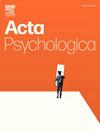The impact of leisure physical activity on the physical fitness of young adults with intellectual disabilities
IF 2.1
4区 心理学
Q2 PSYCHOLOGY, EXPERIMENTAL
引用次数: 0
Abstract
Background
Individuals with intellectual disability are less physically active than individuals without intellectual disabilities, and rarely reach the recommended daily level of physical activity. There is sufficient scientific evidence for the beneficial effects of exercise on the cardiovascular and muscular fitness of young adults with mild-to-moderate intellectual disabilities.
The aim
To assess the impact of leisure physical activity on the physical fitness of adults with intellectual disabilities.
Method
21 people (35,4 ± 11,61 years) with intellectual disabilities were allocated to two groups: I group (mean age 32,14 ± 9 years, 2 months, 1 t/week) and group II (mean age 38,25 ± 13,39 years, 2 months, 2 t/week). At the baseline and at the end of the intervention, the cardiorespiratory fitness, lower-body muscular strength and endurance, mobility and balance were assessed with 6-min walking (6MWT), lateral step-up (LSUT), sit-to-stand (30CST), Timed Up and Go (TUG) and Tinetti balance tests.
Results
Both groups showed improvements in cardiorespiratory endurance, muscular strength, and balance. Significant improvements were observed in Group I in the TUG (p = 0.002), LSUT (p = 0.001), and 6MWT (p = 0.004) results. Group II also demonstrated progress in TUG (p = 0.010), LSUT (p = 0.008), and 6MWT (p = 0.012), though they did not reach recommended physical activity benchmarks. Significant differences between the groups were observed in leg strength and mobility (p < 0.05). These findings suggest that short-term, low-frequency interventions may be insufficient for individuals with low baseline fitness.
Conclusion
This study fills a gap in the literature by focusing on young adults with ID and shows that leisure PA can yield meaningful functional improvements. However, higher frequency and longer-duration interventions are likely needed to achieve recommended physical activity levels. The findings offer practical insights for developing inclusive, evidence-based PA programs for this underserved population.
Lay summary
For individuals with intellectual disabilities, physical capability is often assessed through abilities essential to daily living—such as coordination, balance, muscular strength, endurance, and flexibility. As people age, functional strength and exercise tolerance tend to decline.
This study showed that in young adults with mild to moderate intellectual disabilities, leisure physical activity improves fitness and mobility and can reduce some cardiovascular risk factors. Programs should prioritize exercises that improve gait, balance, and physical function to lower fall risk and support greater independence. These findings highlight that leisure physical activity is a simple, cost-effective way to promote health in this population.
休闲体育活动对智障青年体质的影响
智力残疾者的体力活动少于无智力残疾者,而且很少达到建议的每日体力活动水平。有足够的科学证据表明,运动对有轻中度智力障碍的年轻人的心血管和肌肉健康有有益的影响。目的探讨休闲体育活动对智力障碍成人体质的影响。方法将21例智力障碍患者(35、4±11、61岁)分为I组(平均年龄32、14±9岁,2个月,1 t/周)和II组(平均年龄38、25±13、39岁,2个月,2 t/周)。在基线和干预结束时,通过6分钟步行(6MWT)、侧举(LSUT)、坐立(30CST)、定时起身(TUG)和Tinetti平衡测试评估心肺功能、下半身肌肉力量和耐力、机动性和平衡性。结果两组患者心肺耐力、肌肉力量和平衡能力均有改善。第一组在TUG (p = 0.002)、LSUT (p = 0.001)和6MWT (p = 0.004)结果上均有显著改善。第二组在TUG (p = 0.010)、LSUT (p = 0.008)和6MWT (p = 0.012)方面也有进展,尽管他们没有达到推荐的身体活动基准。两组之间在腿部力量和活动能力方面存在显著差异(p <;0.05)。这些发现表明,对于基线健康水平较低的个体,短期、低频率的干预可能是不够的。结论本研究填补了文献的空白,通过关注年轻的ID成年人,并表明休闲PA可以产生有意义的功能改善。然而,要达到建议的身体活动水平,可能需要更高的频率和更长的干预时间。研究结果为为这一服务不足的人群制定包容性的、基于证据的PA计划提供了实际见解。对于智力残疾的人来说,身体能力通常是通过日常生活所必需的能力来评估的,比如协调、平衡、肌肉力量、耐力和灵活性。随着人们年龄的增长,功能力量和运动耐受性趋于下降。这项研究表明,在有轻度到中度智力残疾的年轻人中,休闲体育活动可以改善健康和行动能力,并可以减少一些心血管危险因素。计划应该优先考虑改善步态、平衡和身体功能的锻炼,以降低跌倒的风险,并支持更大的独立性。这些发现强调,休闲体育活动是促进这一人群健康的一种简单、经济有效的方式。
本文章由计算机程序翻译,如有差异,请以英文原文为准。
求助全文
约1分钟内获得全文
求助全文
来源期刊

Acta Psychologica
PSYCHOLOGY, EXPERIMENTAL-
CiteScore
3.00
自引率
5.60%
发文量
274
审稿时长
36 weeks
期刊介绍:
Acta Psychologica publishes original articles and extended reviews on selected books in any area of experimental psychology. The focus of the Journal is on empirical studies and evaluative review articles that increase the theoretical understanding of human capabilities.
 求助内容:
求助内容: 应助结果提醒方式:
应助结果提醒方式:


